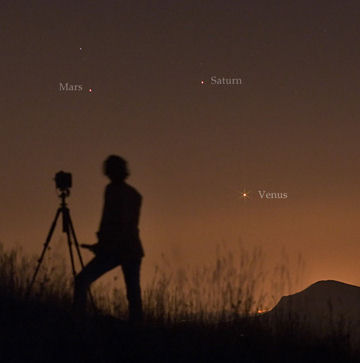iPHONE VS ANDROID! Actually, it doesn't matter which phone you carry. Our cool, new app turns both smartphones into field-tested satellite trackers. Learn more. | | | M-FLARE: At 1825 UT on August 7th, Earth-orbiting satellites detected a long-duration M1-class solar flare. The source of the blast was sunspot 1093. Several amateur astronomers caught the active region in mid-flare. First-look data confirm that the blast produced a CME, but the cloud is not heading directly toward Earth. A glancing blow to our magnetic field on August 9th or 10th might produce auroras, but this does not appear to herald a major space weather event at Earth. Stay tuned for updates. PERSEID METEOR UPDATE: "The Perseids are booming here in Alabama," reports astronomer Bill Cooke of the Marshall Space Flight Center. "Although the peak of the shower is almost a week away, we saw five Perseid fireballs last night (Aug. 5-6). It's a good sign that this year's shower will be a good one." [live meteor radar] [2009 Perseid gallery] [meteor counts] FAREWELL SOLAR MINIMUM: Solar activity is picking up and that gives some astronomers reason to wake up in the morning. "Ah the dawn of a new day... and what a day it was!" says Wouter Verhesen of the Netherlands, who took this picture of the morning sun on August 6th: 
"There were massive prominences sticking out of the sun everywhere, sunspots galore, and even a small flare in AR1093," says Verhesen. "I can't remember the last time I had so much to do with my small solarscope. Farewell solar minimum, you will not be missed!" Indeed it will not. Browse the links for more reasons why: from the Solar Dynamics Observatory in Earth orbit; from Alan Friedman of Buffalo, NY; from Michael Buxton of Ocean Beach, California; from Thierry Legault of Elancourt, France; from Cai-Uso Wohler of Bispingen, Germany; from Paul Andrew of Dover, Kent, UK; from Fabio Mariuzza of Biauzzo - Italy SUNSET PLANETS: When the sun goes down tonight, step outside and look west. You might see something like this: 
Babak Tafreshi sends the picture from the Alborz Mountains of Iran. "Venus, Saturn and Mars are in triple conjunction," says Tafreshi, "and they will be at their most beautiful in the nights ahead." Next week, on August 12th, the trio will become a quartet when the crescent Moon joins the planets for an amazing four-way conjunction. Even more amazing, it happens on the peak-night of the Perseid meteor shower. Astronomy doesn't get much better than this! sky maps: August 7, 8, 9, 10, 11, 12, 13 more images: from Richard Glenn of Gold Beach, Oregon; from Tom Wagner of Waterloo, Iowa; from Giuseppe Pappa of Mascalucia, Sicily, Italy;
August 2010 Northern Lights Gallery
[previous Augusts: 2009, 2008, 2007, 2006, 2005, 2004, 2003]
Solar Eclipse Photo Gallery
[NASA: South Pacific Eclipse] [animated map] | 
